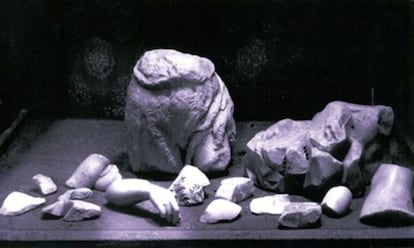Michelangelo statue to return to Andalusia
Now back in one piece, 'Young St John' is headed to Úbeda


Everybody in town had heard about it but almost no one had seen it. The 15th-century sculpture of Young St John, or St John the Baptist as a Child, attributed to Michelangelo, had been reduced to pieces during an attack that destroyed several artworks in the main altar of the Salvador Chapel in Úbeda, Jaén province, in August 1936.
Now, 77 years later, the marble statue of the saint is about to be brought back to life after complex restoration work in Italy. Once complete, it is set to return to the renaissance city - made a Unesco World Heritage site along with nearby Baeza in 2003 - where everyone had given it up for lost.
It was back at the start of 1995 that the Casa Ducal de Medinaceli Foundation, which owns the Salvador Chapel, sent the preserved fragments of the sculpture (rumor has it a local had kept the head in his house) to the Opificio delle Pietre Dure in Florence, one of the most important preservation institutes in the world. Piecing together the 17 fragments, which barely comprised 40 percent of the total, had looked like an impossible mission. But after 18 years and many delays, the restoration is set to be unveiled on June 24 and 25 in Florence to coincide with its celebrations of St John's Day, the patron saint of the city. At the same time, more details of its restoration, history and the latest news on its attribution will also be made public.
Using the latest 3D laser-scanning technology, Vicenza-based company Unocad developed a method to reconstruct the measurements of the sculpture from the fragments and the few surviving photographs of it from before its destruction.
The 130-centimeter-high sculpture shows a 10-year-old John the Baptist wearing a lamb's fleece draped over his left shoulder and secured round his waist with a belt. It was bought to Spain by Francisco de los Cobos, secretary to and a favorite of Holy Roman Emperor Charles V. He received it as a gift from the Republic of Venice after his first trip to Italy between 1529 and 1533, when he accompanied the emperor during his triumphal journey following his coronation in Bologna.
Piecing together the 17 fragments had looked like an impossible mission
In Úbeda the statue occupied a prominent place in the main altar of the Salvador Chapel, which De los Cobos had ordered built in 1536. A great collector, he brought together artworks he had acquired or been given on his travels around Europe with Charles V, then the most powerful man in the world, to decorate it. De los Cobos, who died in 1547, now lies buried beneath the enormous dome that crowns the chapel's main altar.
In 1930, the renowned historian Manuel Gómez-Moreno said he had no doubt that Young St John was the work of Michelangelo and that it was the same sculpture that had been created in 1495 for Lorenzo di Pierfrancesco de' Medici, which had been given up for lost since the 17th century. Since then others have doubted that attribution, but no one has questioned the fact that it was created at the end of the 15th-century in Florence or that it had links to Michelangelo's workshop.

La Casa Ducal has declined to release details about the "pioneering" restoration process, nor about the research being carried out to determine if the sculpture really was the work of Michelangelo. But the foundation has revealed that it is to return to the Salvador Chapel in Úbeda. "Not on the main altar, where it was, for preservation reasons, but in a room located over the vestry, where the history of the piece and its return will be explained," Juan Manuel Albendea, director general of the foundation, reveals. "Its final location will depend a lot on the consensus about its attribution."
According to information gleaned by EL PAÍS, the recent research has confirmed the attribution of the work to Michelangelo. One of the lines tracing the sculpture's journey from Italy to Spain relates to the collecting passion of De los Cobos and his relationship with Vittoria Colonna, the powerful wife of Francisco Fernando de Ávalos, a Spain-born Neapolitan nobleman and one of Charles V's most distinguished soldiers. As well as a poet, Colonna was a patron to artists such as Michelangelo, with whom she shared a passionate friendship. To find out more details about that relationship, however, we will have to wait until June in Florence.
Tu suscripción se está usando en otro dispositivo
¿Quieres añadir otro usuario a tu suscripción?
Si continúas leyendo en este dispositivo, no se podrá leer en el otro.
FlechaTu suscripción se está usando en otro dispositivo y solo puedes acceder a EL PAÍS desde un dispositivo a la vez.
Si quieres compartir tu cuenta, cambia tu suscripción a la modalidad Premium, así podrás añadir otro usuario. Cada uno accederá con su propia cuenta de email, lo que os permitirá personalizar vuestra experiencia en EL PAÍS.
¿Tienes una suscripción de empresa? Accede aquí para contratar más cuentas.
En el caso de no saber quién está usando tu cuenta, te recomendamos cambiar tu contraseña aquí.
Si decides continuar compartiendo tu cuenta, este mensaje se mostrará en tu dispositivo y en el de la otra persona que está usando tu cuenta de forma indefinida, afectando a tu experiencia de lectura. Puedes consultar aquí los términos y condiciones de la suscripción digital.
Últimas noticias
The complicated life of Francesca Albanese: A rising figure in Italy but barred from every bank by Trump’s sanctions
Half of Scotland is in the hands of 420 property owners
Pinochet’s victims grapple with José Antonio Kast’s rise in Chile
Reinhard Genzel, Nobel laureate in physics: ‘One-minute videos will never give you the truth’
Most viewed
- Why we lost the habit of sleeping in two segments and how that changed our sense of time
- Trump’s obsession with putting his name on everything is unprecedented in the United States
- Charles Dubouloz, mountaineering star, retires at 36 with a farewell tour inspired by Walter Bonatti
- The Florida Keys tourist paradise is besieged by immigration agents: ‘We’ve never seen anything like this’
- Living in a motorhome due to soaring housing prices in Madrid: ‘I got used to it quickly, but I don’t idealize it’








































